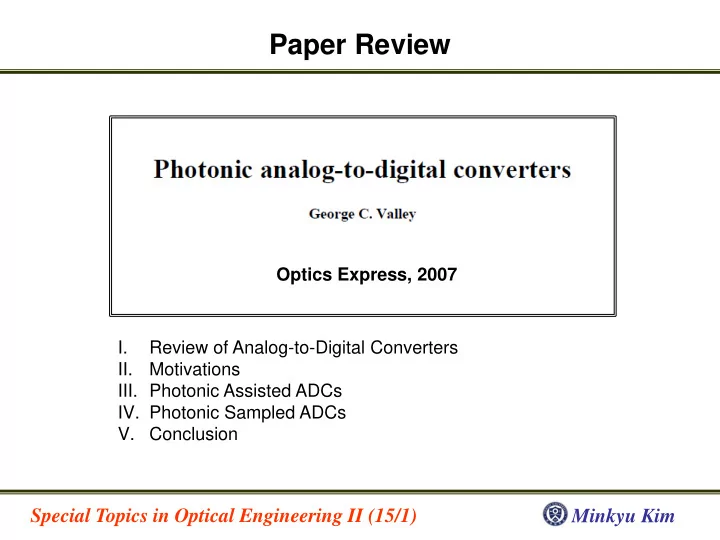

Paper Review Optics Express, 2007 I. Review of Analog-to-Digital Converters II. Motivations III. Photonic Assisted ADCs IV. Photonic Sampled ADCs V. Conclusion Special Topics in Optical Engineering II (15/1) Minkyu Kim
Analog-to-Digital Converter • Analog-to-digital converter -Sampling(S/H or T/H) + Quantization(Quantizer) -Sampling frequency, resolution(N bits) are important specs ex)6-bit 500MS/sec ADC Special Topics in Optical Engineering II (15/1) Minkyu Kim
ADC Basics <Sampling & Quantization> <V in vs Digital Output & Quantization error> • SNR Calculation 𝑊𝑀𝑇𝐶 2 1 2 𝑒𝑊 = 𝑊 3 2 2 2𝑂 -Quantization error energy = 2 𝑊 𝑀𝑇𝐶 𝑊 𝑀𝑇𝐶 -SNR(Signal-to-Noise Ratio) = 𝑝𝑣𝑢 𝑊𝑀𝑇𝐶 12 − 2 SNR(dB) = 1.76 + 𝑂 × 6.02 𝑢=𝑈 𝐵𝑡𝑗𝑜 2 𝜕𝑢 𝑒𝑢 = 𝐵 2 2 2𝑂 𝑊 2 1 -Signal energy = 2 = 𝑀𝑇𝐶 𝑈 N = [SNR(dB)-1.76]/6.02 𝑢=0 8 Special Topics in Optical Engineering II (15/1) Minkyu Kim
Resolution Degradation <Actual quantization with noise and nonlinearities> • Factors inducing resolution degradation (1) Timing errors : random jitter, broadening of the sampling time (2) Amplitude errors : Random noise, nonlinearities • ENOB(Effective Number Of Bits) -Effective resolution from N -ENOB = [SINAD(dB) – 1.76]/6.02, SINAD(SIgnal-to-Noise And Distortion) Special Topics in Optical Engineering II (15/1) Minkyu Kim
Motivation for Photonic ADCs <State-of-art in electronic ADCs> Limited by many factors(Thermal noise, jitter, etc) Photonic ADC push performance to limitations Special Topics in Optical Engineering II (15/1) Minkyu Kim
Classes of Photonic ADCs • Photonic Assisted ADCs -Electronic ADCs that use photonics to improve limiting properties • Photonic Sampled ADCs -Only sampling is performed in the optical domain • Photonic Quantized ADCs -Only quantization is performed in the optical domain • Photonic Sampled & Quantized ADCs -Both sampling & quantization is performed in optical domain Special Topics in Optical Engineering II (15/1) Minkyu Kim
Optical Link & Photonic ADCs <Generic analog optical link> • • CNR(Carrier-to-Noise Ratio) SFDR(Spur-Free Dynamic Range) 𝑛𝑆𝑄 2 /2 -Nonlinearities in an analog optical link - 𝐷𝑂𝑆 = 2 +𝜏 𝑆𝐽𝑂 2 2 +𝜏 𝑢ℎ (𝜏 𝑡 ) -Caused by both optical devices and RF -CNR is used in place of SNR in analog link spectrum - 𝐹𝑂𝑃𝐶 = 𝐷𝑂𝑆 𝑒𝐶 − 1.76 /6.02 -No general formulation for arbitrary input spectra 𝑛 ∶ 𝑁𝑝𝑒𝑣𝑚𝑏𝑢𝑗𝑝𝑜 𝑒𝑓𝑞𝑢ℎ 𝑆 ∶ 𝑆𝑓𝑡𝑞𝑝𝑜𝑡𝑗𝑤𝑗𝑢𝑧 𝑝𝑔 𝑄𝐸 𝑄 ∶ 𝑃𝑞𝑢𝑗𝑑𝑏𝑚 𝑞𝑝𝑥𝑓𝑠 𝜏 𝑡 : 𝑇ℎ𝑝𝑢 𝑜𝑝𝑗𝑡𝑓 𝜏 𝑢ℎ : 𝑈ℎ𝑓𝑠𝑛𝑏𝑚 𝑜𝑝𝑗𝑡𝑓 𝜏 𝑆𝐽𝑂 : 𝑆𝐽𝑂 𝑜𝑝𝑗𝑡𝑓 Special Topics in Optical Engineering II (15/1) Minkyu Kim
Optical Link & Photonic ADCs Assume RIN = 0, no path loss, linear <ENOB as a function of link BW for an analog optical link> High optical power is required for high resolution(>10 ENOB) Moderate resolution & 10s of bandwidth ADC may be a better target for photonic ADCs Special Topics in Optical Engineering II (15/1) Minkyu Kim
Photonic Assisted ADCs Modes of cavity Periodic impulse train I. Sample using mode-locked laser FFT Δ ω Δ T ω t × ∗ Gain curve Short pulse <General schematic of photonic assisted ADC> • Advantages -Faster rise time and lower pulse-to-pulse jitter ω t = = -Can remove clock from ADC circuit with fiber -Address multiple points from one optical source Mode locked source Short pulse train • Disadvantages Δ T - Integrating mode locked laser into commercial product is hard ω t Special Topics in Optical Engineering II (15/1) Minkyu Kim
Photonic Assisted ADCs II. Optical track & hold -Limitation of direct illumination of a single optoelectronic switch (1) Capacitor is charged by weak input signal(Track) (2) Semiconductor lifetime is not enough short(Hold) a. Diode bridge • No optical pulse : diode bridge works(Track) • Optical pulse : diode bridge off(Hold) • Advantages -Reduced aperture time -Low clock jitter -Clock isolation No clock/signal interference • 1 GS/s, 9.6 SNR bits achieved <Photonic assisted ADC using diode bridge circuit> Special Topics in Optical Engineering II (15/1) Minkyu Kim
Photonic Assisted ADCs II. Optical track & hold b. Photonic-assisted time-interleaved ADC <Electronic time-interleaved ADC> <Photonic assisted time-interleaved ADC> <Optically triggered differential S/H circuit> • 4 ENOB for input bandwidth up to 40 GHz achieved approximately 6 times bandwidth of electronic ADCs Special Topics in Optical Engineering II (15/1) Minkyu Kim
Photonic Assisted ADCs III. Optically triggered electron beam ADC <Basic cathode ray tube ADC> <Optically triggered e-beam ADC> • Using mode-locked laser low-jitter high repetition rate train of light pulse • ~4 ENOB for input bandwidth up to 100 GS/s achieved Special Topics in Optical Engineering II (15/1) Minkyu Kim
Photonic Sampled ADCs I. Photonic sampled ADC without DeMUX <Photonic sampled and electronically quantized ADC> • All of the timing characteristics are controlled by the low-noise optical clock • Sampling time is set by the pulse width, the bandwidth of modulator • Timing jitter is set by jitter of the laser • Several issues exist -Modulator linearity -PD responsivity -PD recovery time DeMUX data Special Topics in Optical Engineering II (15/1) Minkyu Kim
Photonic Sampled ADCs II. Photonic sampled and demultiplexed ADC <Photonic sampled and demultiplexed ADC> • Achieved 505MS/s, ENOB = 9.8 • Two major sources of error : pulse-to-pulse amplitude fluctuation, timing jitter • Path matching is hard, calibration is needed Special Topics in Optical Engineering II (15/1) Minkyu Kim
Conclusion • Review of electronic ADCs • Overcome limitation of electronic ADCs with photonic ADCs • Photonic assisted ADCs • Photonic sampled ADCs Special Topics in Optical Engineering II (15/1) Minkyu Kim
Recommend
More recommend